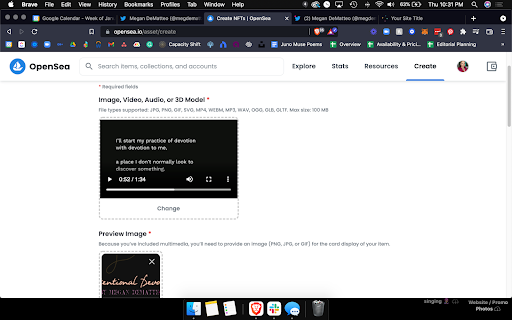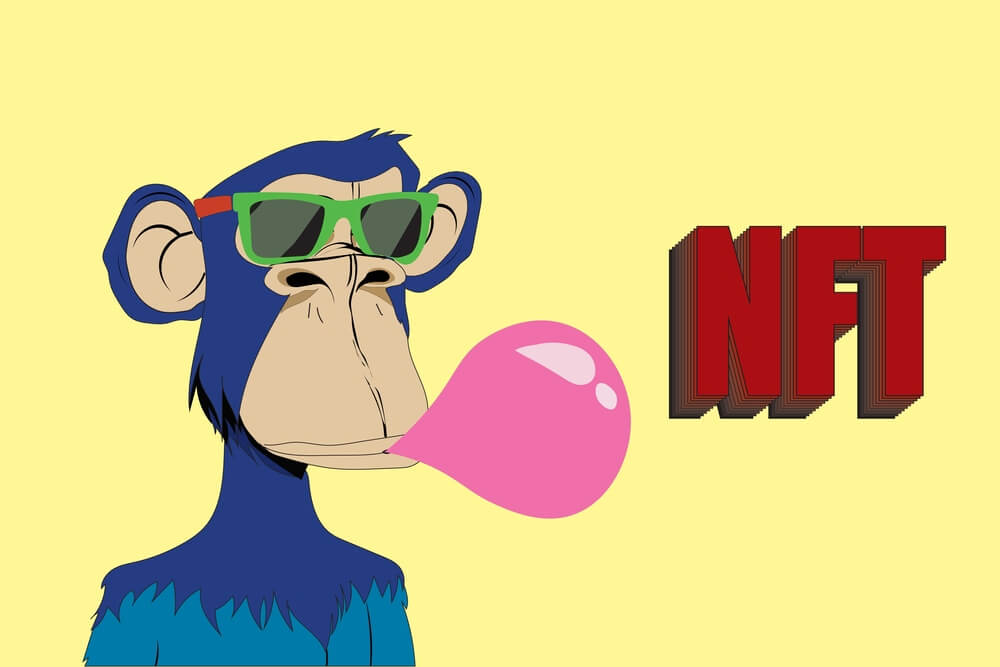Payments in internet culture – or by their more familiar name, Web 3 culture – got me thinking I can shill my content for 1 ETH ($3,000) a pop.
And on February 5, 2022, I did. After all, imposter syndrome doesn’t have a place in a burgeoning industry where even founders admit to being amidst a learning curve. If I were a creator during Gutenberg’s era, I wouldn’t have passed up the chance to play with the printing press. Why should NFTs be different?
When I first heard about non-fungible tokens (NFTs) in August 2021, I was immediately thrilled by their high-level concept of them: Artists, seemingly overnight, now had a way to own their work and determine their royalties. I needed to understand more about it.
Being a journalist, I was fortunate that my first conversation about NFTs was with Whale Shark, a prominent collector and founder of the WHALE token.
Ahead, I share what I’ve learned since that first NFT conversation and my chats with dozens of creators and founders in the blockchain world. As they say in crypto, time moves so fast. One month is a year, and it took me about seven months – essentially one whole dog year – to finally work up the nerve to put one of my poems on a blockchain. I’d like to make it easier for you.
Here’s a step-by-step guide on how to mint your first NFT using OpenSea, a popular NFT platform among first-time creators. (Great alternative platforms also exist, which we’ll touch on below.)
Step 1: Decide on the concept.
Outside of my financial journalistic work, I have a growing affinity for all things astrology-based. Looking at my recent astrology chart with astrologer Noah Frere, I noticed that Juno was very active. In light of this, I decided to base my first NFT collection on the tumultuous relationship between Juno and Jupiter – two gods from Roman mythology. And after a great conversation with my business coach, I knew I wanted to explore the tension between love and duty through the lens of devotion.
I, therefore, decided to name my poetry alter ego – every creator needs one, right? – “Juno Muse.”
With my concept nailed down, I had my marching orders: Resurrect my old poems and write several new ones. Then, learn how to mint them on a blockchain.
Step two: Decide on the platform.
The tech skills required to mint NFTs on OpenSea are comparable to the ones I used to sign up for Myspace in 2006.
“There's a big misconception that you have to be technical to participate in crypto,” said Denise Schaefer, co-founder of the blockchain education platform Suge. “But I see NFTs as a fun entryway into the space that doesn't require coding skills when minting in marketplaces like OpenSea or Rarible.”
Here are some beginner-friendly NFT platforms where first-time creators can mint:
OpenSea
- Blockchains used: Ethereum and Polygon
OpenSea is popular and easy to use for all types of NFTs. While the Ethereum blockchain is notorious for charging high service fees, or “gas", OpenSea now has a lazy mint option. The creator can upload their artwork, “mint” it to their profile, and list it for sale without paying gas fees. When the collector buys it, they will pay the gas fees.
What you’ll need to get started:
An ETH wallet (e.g. Plasbit, Metamask, Coinbase, or dozens of others)
Creator fees:
2.5% of your sale
Learn more:
Visit the OpenSea resource page.
Rarible
- Blockchains used: Ethereum, Flow, and Tezos
Creators can use Rarible to mint NFT creations, whether books, music albums, digital art, or movies. There are some fun features, such as the ability to show a “sneak peek” of your creation to everybody who comes to Rarible but limit the full project to purchasers only.
Rarible considers itself a community-owned NFT marketplace. Using Rarible’s unique token (ERC-20 RARI) makes you an owner of the Rarible project. This is a cool feature, but it was a little over my head for my first mint. I hope to learn more about this.
What you’ll need to get started:
A wallet is compatible with your choice of blockchain.
Creator fees:
Vary depending on the blockchain you use, but the option for free minting exists.
Learn more:
Read the Rarible FAQs
Holaplex
- Blockchain used: Solana
While Solana has mixed reviews from Ethereum loyalists, artists and creators report that the Solana blockchain is super fast, has high performance, and is cost-effective with negligible fees. Solana’s speed and efficiency also cut down on energy usage, giving it a reputation as a new, less environmentally damaging alternative to Ethereum.
What you’ll need to get started:
Phantom wallet and Arconnect Wallet
Creator fees:
Reportedly 0.000005 SOL ($0.00025) per transaction. Fees can fluctuate, but they are almost zero.
Learn more:
Check out this Artist’s Guide to Solana and Holaplex and visit the Holaplex.
Objkt
- Blockchain used: Tezos
Created as a secondary marketplace, objkt now allows artists and creators to mint directly on its platform. It’s also popular among literary NFT creators and used by theVerseVerse co-founders Sasha Stiles and Ana Maria Caballero.
What you’ll need to get started:
Choose from these compatible wallets:
- Spire
- Temple Wallet
- Galleon
- Kukai Wallet
- Umami
- AirGap Wallet
Creator fees:
2.5% for all successful sales
Learn more:
Visit the objkt website and/or discord server.
Step three: Connect and build a community
Get ready to tweet and DM. If you want to start making NFTs, you’ll need to dust off your Twitter account. You’ll also need to join Discord, a Slack-like chat platform for gamers and crypto lovers. Expect to get most of your information and build authentic relationships through these communication channels.
When you’re ready to sell your NFTs, expect your community to be your number-one marketing resource. It sounds a little cliche, but you don’t need to spend much money on sophisticated marketing tactics to create a successful project.
“Regardless of how low or high the market is, the community is so enthusiastic and constantly tagging our project in different things and constantly talking about it,”
“We have not put in even $1 in marketing so far, but we were just featured in Vanity Fair yesterday and today in Rolling Stone,”
Even 1-of-1 creators – artists who mint unique, single pieces of art, compared to algorithmically generated avatars that people use as Twitter profile pictures – seemingly trust that making friendships can go a long way.
Step four: Create your art
To start turning my poems into art, I asked my mom to mail me an old iPad she wasn’t using and signed up for an online illustration class at the Baltimore Academy of Illustration. I bought an Apple Pencil, downloaded Photoshop for iPads, and plugged in my Yeti microphone (which I already had) to practice recording audio clips in iMovie and GarageBand. I dug out my old poems from grad school, walked around Manhattan thinking of ideas, and bought a notebook to start scribbling.
Every creator has their own process, but no matter what, you need to think about how your art will translate digitally. Follow these guidelines to make your first NFT:
- Use materials and tools you already have.
- Invest in new technology or knowledge as needed.
- Find other creators and learn from each other.
- Consider the audience you think will like your work and keep them in mind as you create.
- Choose whether you want your NFTs to have visual, audio, or written components – or all three.
- Pick a file type. OpenSea accepts JPG, PNG, GIF, SVG, MP4, WEBM, MP3, WAV, OGG, GLB, and GLTF.
- Think about the file size. OpenSea’s limit is 100 MB.
- Accessibility factor – I chose to have subtitles along with my spoken-word poems so that as many people could enjoy them as possible, including people with visual and/or hearing impairments.
After some experimenting, I ended up scrapping the graphics I created in Photoshop and instead used Canva to make a simple title image and subtitles for my poem. I then recorded myself reading the poem along with the slides.
I’m not the most talented visual artist. But I permitted myself to play around – and I don’t intend to stop experimenting. The advice I’ve gotten is this: Don’t pigeonhole yourself too soon or limit your notions of what’s possible. Unless you have a clear aesthetic like Abidi, an Experienced painter experienced painter]], consider NFTs your opportunity to try new things. NFTs are a new art form, so let your message translate to the new medium.
Step five: Mint and share
In OpenSea, the minting process is so easy I kept waiting for a clown to jump out and tell me I’d been tricked.
It’s as simple as uploading your files, inputting your collection’s description and making your profile, determining your royalties (for later, when your art is sold in a secondary marketplace), and completing your listing.
Note the accepted file types:

I chose to mint my first NFT on Polygon, which had no fees.
Once you mint your NFT, you will see it on your profile. Blockchain data is public and accessible to anyone. Your NFT's buying and selling history will be available forever, helping you and prospective investors track its price.
“Etherscan is where you can see all the transactions in the Ethereum blockchain,” Schaefer told CoinDesk. “It is specific to all transactions occurring in the Ethereum network and in and out of the network. Access to these public records allows blockchains to operate without a central authority and a bank.”

But you might not want the whole world to know how much money you have and how much money you're transacting, said Schaefer. This is where pseudonyms and having multiple wallets - legal in the blockchain world – come in.
The final step: Selling your NFT
After minting, it’s time to list your NFT for sale. I opted to keep things simple and list mine for 1 ETH, or $2,922.42, at the time of minting.
My 1 ETH price will remain on my Juno Muse OpenSea profile until Feb. 20 or whenever someone takes my NFT off the market.
In the meantime, I plan to keep experimenting with how I price my NFTs. I plan on releasing my old grad school poems, and to make Juno proud, I plan to keep writing poems on Thursdays, which are ruled by Juno’s love, Jupiter. Maybe, just maybe, this new routine will help me fall in love with NFTs and – most important – my art again.







